What do moving boxes, book covers, and your favorite board game have in common? They likely all use some form of pappendeckel. This German term, often translated as cardboard or board, describes a material so common we often overlook its importance. Yet, pappendeckel is a foundational element in countless industries and daily routines. It provides structure, protection, and a surface for creativity. This article will explore its uses, properties, and significant impact on our world.
Understanding “Pappendeckel”: From Material to Everyday Use
Pappendeckel isn’t just a fancy word for paper. It represents a broad range of manufactured board products. Its strength and versatility set it apart, making it suitable for many applications where standard paper wouldn’t work. Think about the sturdy packaging that protects electronics or the rigid backing on a picture frame. This material offers both function and adaptability.
What is Pappendeckel? The Basics of Board and Cardboard
Simply put, pappendeckel refers to various types of board or cardboard. It’s thicker and more rigid than paper. How is it made? Primarily from wood pulp, which is processed and pressed into sheets of varying thickness. This process gives pappendeckel its characteristic strength and stiffness. From a simple cereal box to industrial-grade shipping containers, it’s all part of the pappendeckel family.
Different Types of Pappendeckel and Their Properties
Not all pappendeckel is the same. Manufacturers create different types, each with unique properties for specific uses.
- Corrugated Cardboard: This is perhaps the most recognizable type. It has a fluted (wavy) layer sandwiched between two flat liners. This design provides exceptional strength and cushioning, making it ideal for shipping boxes. You’ll find it protecting everything from furniture to fragile glassware.
- Greyboard: This dense, rigid board often appears in book covers, binders, and sturdy boxes. It’s known for its stiffness and smooth finish, providing a solid foundation for printed materials.
- Chipboard: A more economical option, chipboard often serves as backing material for notepads, picture frames, or in displays. It’s less refined than greyboard but still offers good rigidity for many applications.
- Folding Carton Board: This lighter, foldable board is perfect for retail packaging, like food boxes or cosmetic cartons. It offers excellent printability, allowing for vibrant graphics and branding. It’s designed to be cut, creased, and folded into attractive shapes.
Each type of pappendeckel offers a combination of strength, flexibility, and surface quality. This allows it to meet the demands of many different products and environments.
The Versatile Applications of Pappendeckel Across Industries
The uses for pappendeckel go far beyond simple boxes. It plays a critical role in packaging, construction, arts, and crafts. Its adaptability makes it useful in many diverse fields. This material’s specific properties make it an ideal choice for countless applications.
 Photo by Darren Patterson
Photo by Darren Patterson
Pappendeckel in Packaging: Protecting and Presenting Goods
The packaging industry relies heavily on pappendeckel. It’s essential for both protecting and presenting goods.
- Shipping Boxes (Corrugated): These boxes are the backbone of logistics. They protect products during transit, absorbing shocks and impacts. They often feature printed information, handling instructions, and branding.
- Product Packaging (Folding Cartons): From cereal boxes to medicine cartons, folding cartons not only protect items but also serve as a crucial marketing tool. Their smooth surfaces allow for high-quality printing, eye-catching graphics, and product information.
- Protective Inserts: Inside larger boxes, pappendeckel inserts keep items separate and cushioned. They prevent movement and reduce the risk of damage, ensuring products arrive safely to consumers.
Pappendeckel’s role here is twofold. It provides structural integrity and cushioning. It also offers an excellent surface for branding and communicating important information to consumers.
Creative and Practical Uses Beyond Packaging
Beyond its dominant role in packaging, pappendeckel finds its way into many other creative and practical applications.
- Bookbinding and Stationery: Greyboard creates the sturdy covers of hardcover books and the rigid backings of notebooks and clipboards.
- Game Boards and Puzzles: The flat, rigid nature of certain pappendeckel types makes them perfect for creating durable game boards and puzzle pieces that can withstand repeated handling.
- Model Making and Theatrical Props: Its ease of cutting, folding, and gluing makes pappendeckel a favorite material for hobbyists and professionals alike. Artists use it to construct architectural models, miniature landscapes, and stage props.
- Temporary Furniture and Displays: Some specialized forms of pappendeckel are strong enough to form temporary furniture or retail display units. These provide affordable and often recyclable options for events or promotional setups.
- Arts and Crafts & Educational Settings: Children and adults use pappendeckel in countless art projects. It’s an affordable and accessible material for drawing, painting, constructing, and creating educational aids.
Its versatility comes from how easily it can be cut, folded, and glued. This makes it a valuable resource for designers, artists, and educators.
Conclusion
Pappendeckel, in its many forms, is an essential material in modern life. From the robust corrugated boxes that deliver our online orders to the delicate folding cartons that hold our medicines, its presence is everywhere. We’ve explored its definition, various types, and broad applications. We’ve seen how its properties make it suitable for everything from protective packaging to artistic creations. This humble yet vital material provides structural integrity, serves as a canvas for branding, and protects countless goods.
Beyond its practical uses, pappendeckel also offers significant environmental advantages. It is often made from renewable resources, primarily wood pulp. Most importantly, it is highly recyclable, contributing to a circular economy. As we move forward, appreciating pappendeckel’s quiet efficiency and sustainable nature becomes increasingly important. Its role as a reliable and eco-conscious material secures its place for the future.

